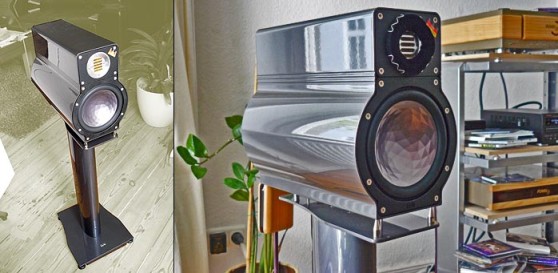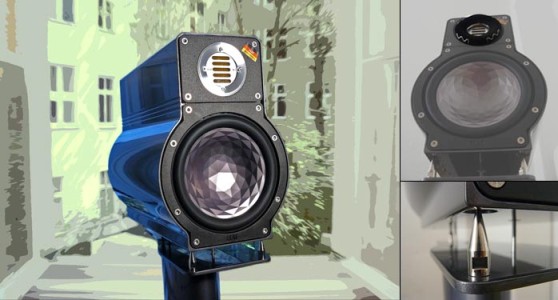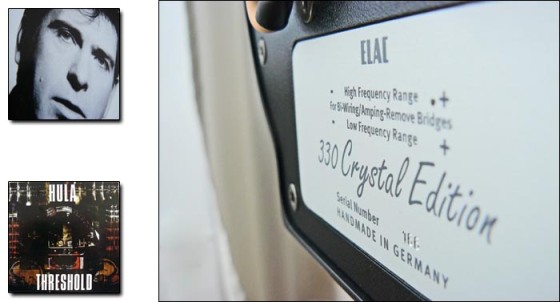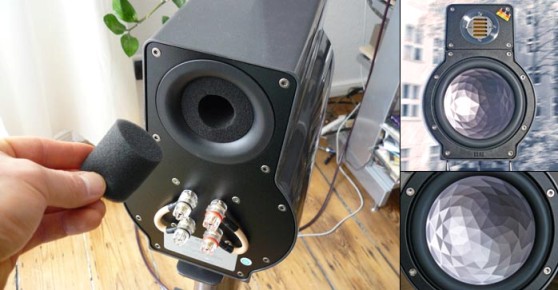ELAC 330 Crystal Edition
Taste, beliefs, preconceptions. Which is it? Certainly not objective truths I could back with solid science. Even outside hifi, certain things I'm not completely behind. In this hobby, take biwire terminals. Or turntables (no hate mail, please; including from press colleagues). Or monitor speakers. And... well, I best stop here to add than in the first two instances, it's not necessarily sonic doubt that governs my biases. It's sheer pragmatism. The obsessive hunt after good sound needs to be grounded from time to time.
Pragmatism and mini monitors aren't equally wedded. Instead, I'd always viewed those as compromises. Past tense that. Even if I haven't converted completely yet where such speakers go, on the listening joy versus euro meter I am getting considerable warmer. And today's 330CE tester by ELAC isn't even a normal compact loudspeaker. At least if one disregards depth, it's a rather - um, compact compact.
Tech & concept But she isn't normal in other regards either. Start with form factor which admittedly caters to industrial design. ELAC's engineers cite additional acoustic advantages however. Reducing the baffle width surrounding the two drivers to the absolute minimum reduces edge diffraction and wave bending to create a "sound liberated from the enclosure". This unusual chassis isn't MDF but compression-formed aluminum. That maximizes stiffness and resonance attenuation and thus, dilutes box talk. We'll not talk attenuation of material costs however, particularly when ELAC says this enclosure (and the drivers and crossover) are made entirely in Germany. Given global economics, that's a fine point in their favor but no longer true for the matching but optional LS65 stands (€598/pr). Their fit 'n' finish is equally high and with the 330C, creates both integrated cosmetics and literal unity. The 330s ship with a special plate which not only affords the spike-coupled speakers a perfect perch but allows them to be solidly bolted down for topple-proof -- and presumably also acoustically beneficial -- peace of mind. Extra kudos are due ELAC's typical footers applied to the stands. They are of the comfortably adjustable sort and always accompany Elacs in pointy and floor-saving dull trim. Equally typical but specific also to the tester are the kind of drivers used. The 2.900Hz plus range is covered by their in-house developed JET, an evolution of Oskar Heil's popular air motion transformer about which my previous review on ELAC's FS 247 spilled words to not warrant repetition - except that for the 330, ELAC incorporated tweaks to layout, gluing and layering of the folded foil membranes.
For the mid-woofer too, the CE330 essentially copies the aluminium/crystal sandwich diaphragm of the FS 247 but grows the diameter by 30mm to 180. More profound driver tweaks relate to long linear drive technology which is ELAC speak for an under-hung voice coil (short coil, long gap) necessitating a strong magnetic motor. Akin to my descriptions of Thiel's SCS4, it implies that regardless of excursion, the voice coil remains within the magnetic flux field and thus stroke stays linear to distortion. I'll tip my hand early and confirm that in matters of SPL stability and relative to its size, ELAC's 330CE most assuredly makes big waves. Steep filtering assists. The higher the degree of acoustical roll-off between drivers, the less breach into out-of-band frequencies occurs. Between electrical, mechanical and geometry-based influences, ELAC claims ca. 30dB per octave or a 5th-order equivalent. Another ELAC specialty is the included JET DC or Dispersion Control tuning element. It's a foam ring to surround the tweeter primarily when placed in highly reflective live rooms. It bundles the off-axis response into more of a directional beam and attenuates the diffusive reflective sound elements but even the frequency response in the upper range is slightly affected, says the maker. In the listening room To get a handle on sonics, I naturally cued up regular material first. But the real fun begins when musical choices are freely ruled by lust. Take "Black Wall Blue", a nearly jazzy tune by the 80s' avantgarde outfit Hula based in Sheffield [Treshold, 1988]). While no audiophile pearl, it's an honest and dynamically involving cut which despite its studio origins conveys a kind of live atmosphere. Being a clearly energetic transducer, that's exactly what the ELAC 330 CE latched onto. Be it the blistering e-bass attacks, the always sudden sax appearances, the impulsive and quite powerfully hammered piano or percussion, the 300 CE conveys all of it surprisingly intense and spiky. On dynamics and joie de vivre, she's definitely got it going on. Don't judge her a toy hifi on sight because this speaker sounds fundamentally big. It's a mind fuck confirmed by my girlfriend Maria who, lounging on the couch, queried in disbelief but mostly rhetorically (no other boxes were visible) whether it was really those boxes playing. In matters of scale and sonic impact, ELAC's 300 CE is somewhat of a shocker. She definitely impersonates rather "fatter" speakers in this milieu of the minis. This is ably supported by the two-way's LF performance. Peter Gabriel's well-known "Red Rain" [So, 1986] is a number whose bass foundation becomes the make-or-break proposition. In low-fat diet trim, I simply lose my appetite. No fear, ELAC's 330 CE is great fun and surprisingly substantial. It's not wobbly fat but immaculately transparent and sorted and, if at all, only minimally goosed in the upper bass. The e-bass runs which I always associate with porcine grunting are as clean, articulate and 'visible' as I know them from my bigger boxes. Hat's off.
In my space, I actually obtained the best balance when the bass reflex port was reduced to medium diameter via the included foam sleeve to neither breathe completely freely or not at all. This supports the midrange play of saxophone, piano and guitar with mostly happy substance even though at times, their sonority seems facing the dark side to invoke Jedi talk. Fear of thin blood is not on the menu. This naturally affects Julia Stones' childlike voice on "A Book Like This" on her eponymous 2008 album. It's somewhat less pip-squeak than usual and more endowed in the fundamentals. But this subliminally boosted sonority wasn't apparent during relaxed sessions .It took more hair-splitting A/Bs. To avoid misreading my midband comments, the ELAC 300 CE is anything but built for comfort. Fundamentally, the focus is on outlines, visibility and timing. ELAC's signature JET tweeter certainly plays a role with high speed and resolving power to -- not tonally but in the transient domain -- imbue the upper midrange and treble with a certain emphasis. Given clean electronics, this execution won't default into artificial brilliance. In my Fonel chain of Simplicité spinner and Emotion integrate, even borderline masters of intrinsically harder fare like Peter Gabriel's So or TV On the Radio's musically wonderful Dear Science (2008) didn't restrict enjoyment.
If I did relate to the treble a tad more appreciative still with the dispersion control foam ring installed, the JET ultimately surprised with a certain tameness. The uppermost range is somewhat recessed and the ELAC 330 CE thus is no poster child for ultimate extension and ephemerals as captured in the term airiness. Take the spiderwebby cymbal work on Øystein Sevåg's "Hanging Gardens". While the ELAC tracks the development from attack to multi-layered ring out accurately and principally perfect, direct A/Bs against the Thiel SCS4 and Sehring 703SE detected an earthier and darker hue. This trait differentiates the 300 CE from the FS 247 which, though equally fitted with a 3rd-gen JET tweeter, is airier if I'm not mistaken. Given preferences, certain listeners could nearly call that too much. This recalls my Geithain ME150 auditions with colleagues Ralph and Martin. While we all agreed that in matters air, things were somewhat genteel, I was nearly bothered, Ralph not at all and Martin ... well, he acquired the pair. Last but not least, soundstaging. Here ELAC's 330 CE is sheer joy. Its lively and involving personality extends to a first-rate disconnect of the music from the apparent sound sources. Rather than a diffuse sonic cloud, the stage action is exceptionally well organized and sorted. This is a known forté of mini monitors and goes beyond my €5.600/pr phase and time tweaked Sehring S703 SE 3-ways. The small ELAC stages noticeably more accurate and in matters of dimensionality is the more persuasive and involving speaker over my Berliner towers.
Conclusion Looking for a compact speaker of astonishing substance and sonority whose solid bass creates surprising power and scale; whose perfectly free-floating sound dispersion creates toe-tapping excitement by emphasizing timing, image outlines and transparency over understatement and romance without artificial etch? The small ELAC then becomes a mandatory audition. Without doubt, it's a speaker blessedly different from the mainstream. However, grace before truth won't be a choice this accurate speakers makes under questionable conditions. Ancillaries should be neutral, of low distortion and free of sharpness from timing errors. Due to the bass reflex tuning options, short distances and small rooms pose are of no concern and even spaces up to 30 square meters (about what I used coupled to pretty stout height) remain appropriate. Monster SPLs and small stature never go hand in hand of course but for non-excessive parties, ELAC's 330 CE will provide sufficient power. The ELAC 330 CE is characterized by...
Facts:
|
©2008-2025 AudioStereo








